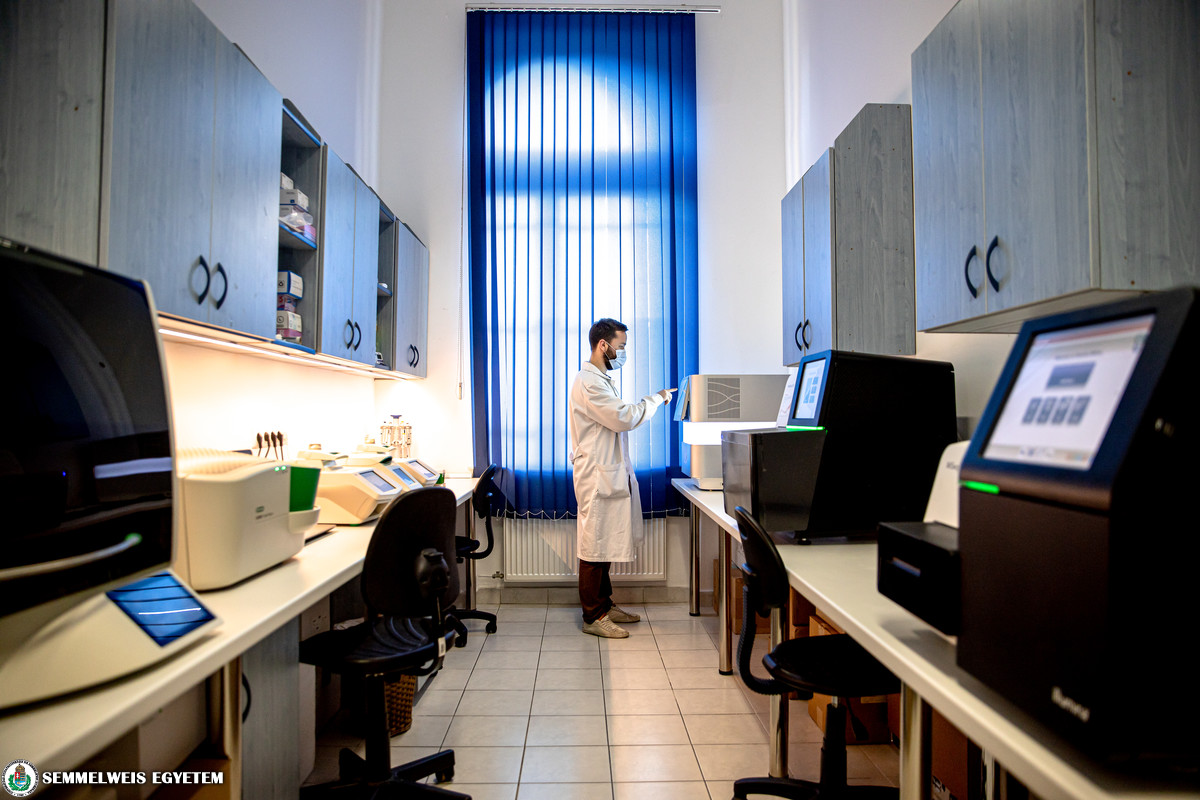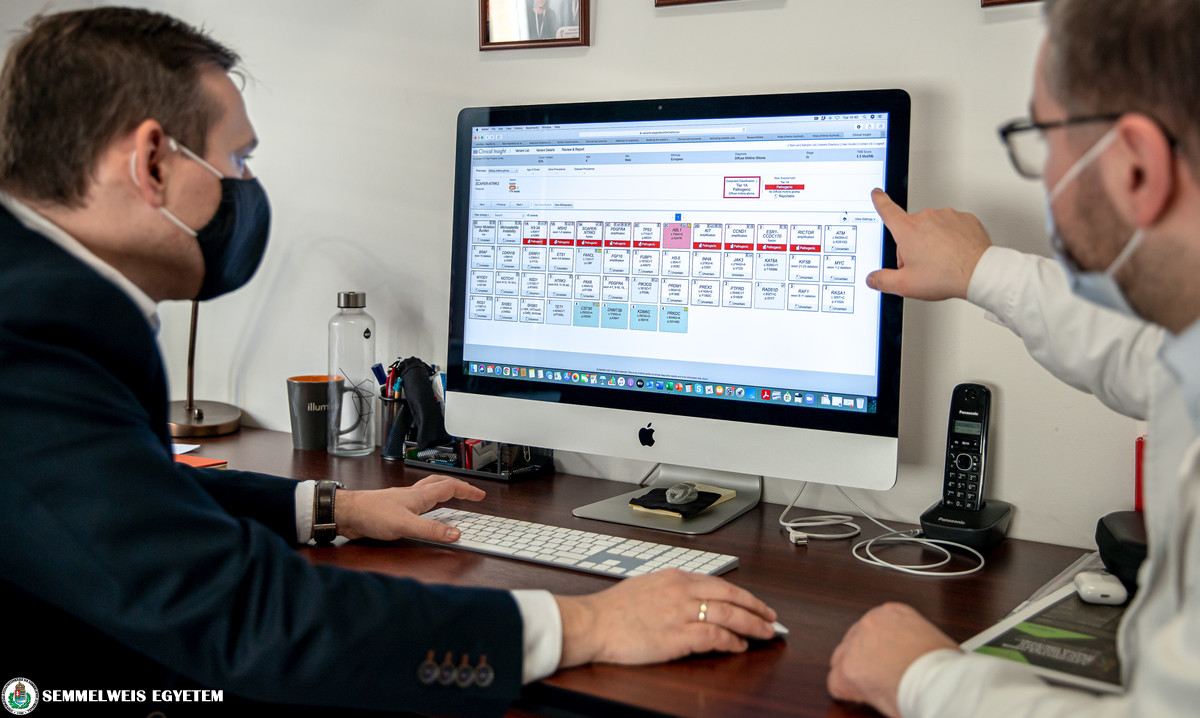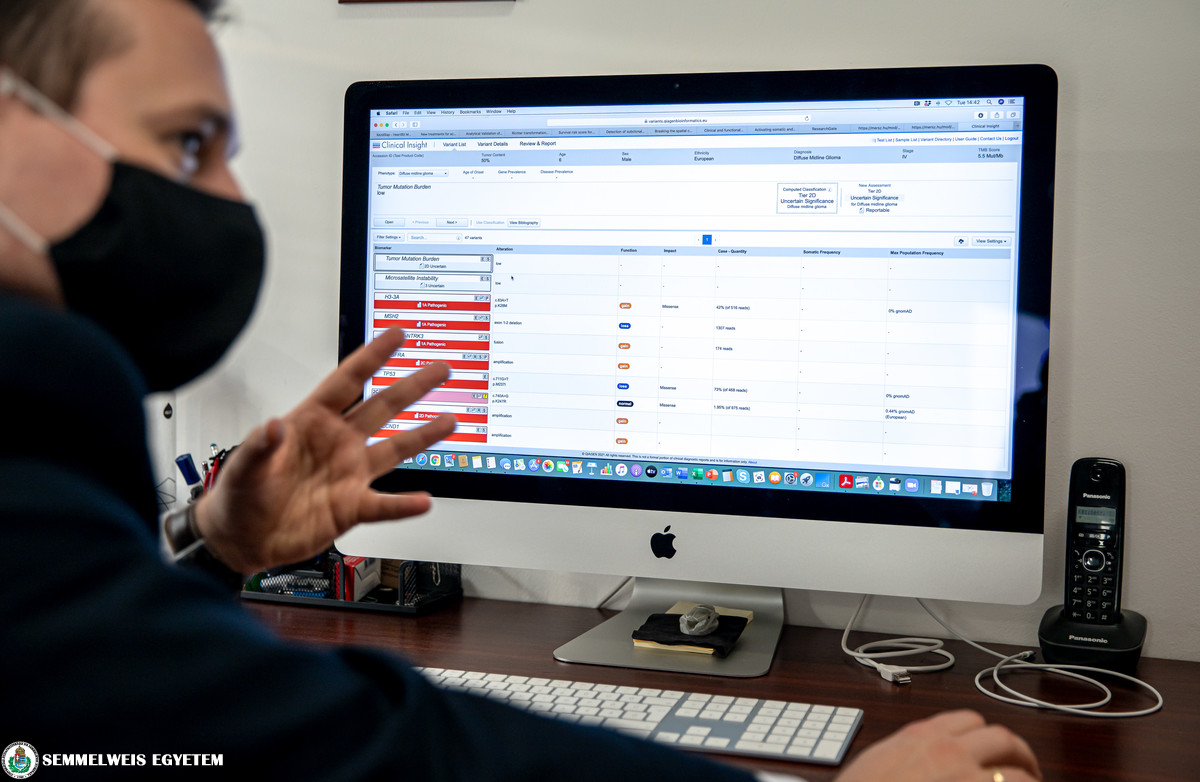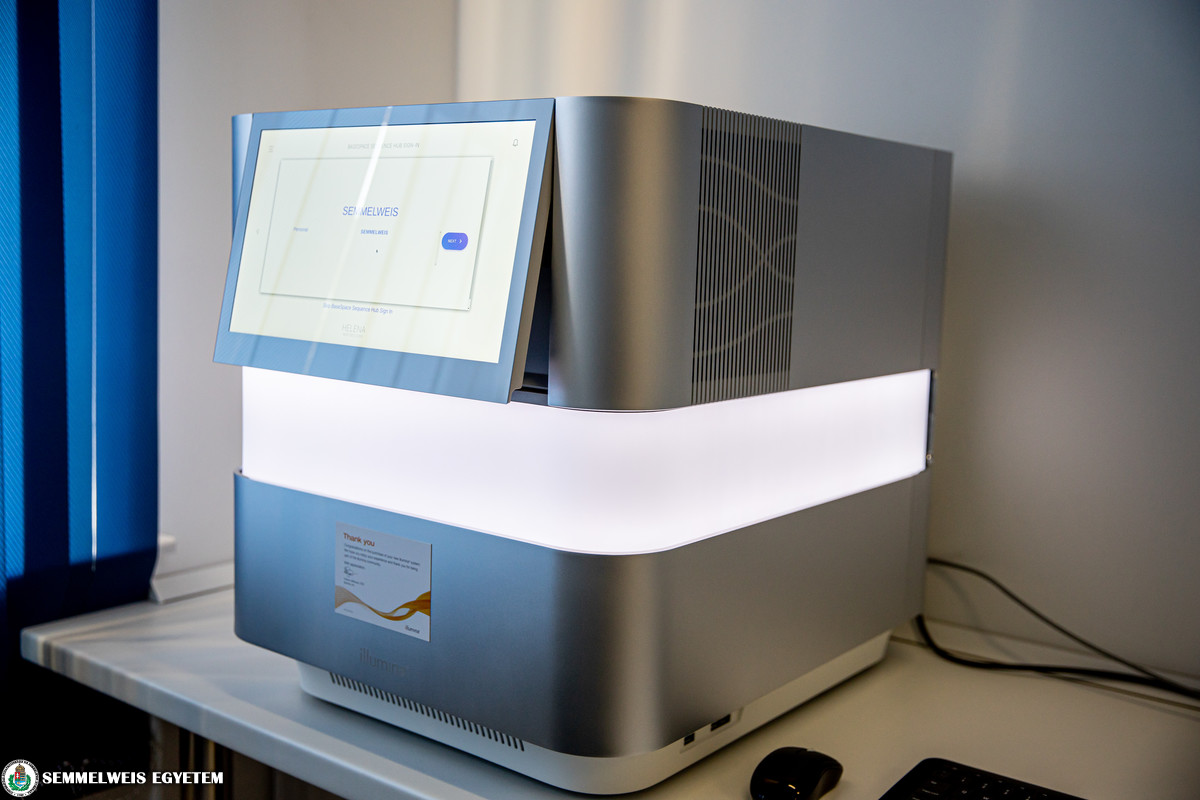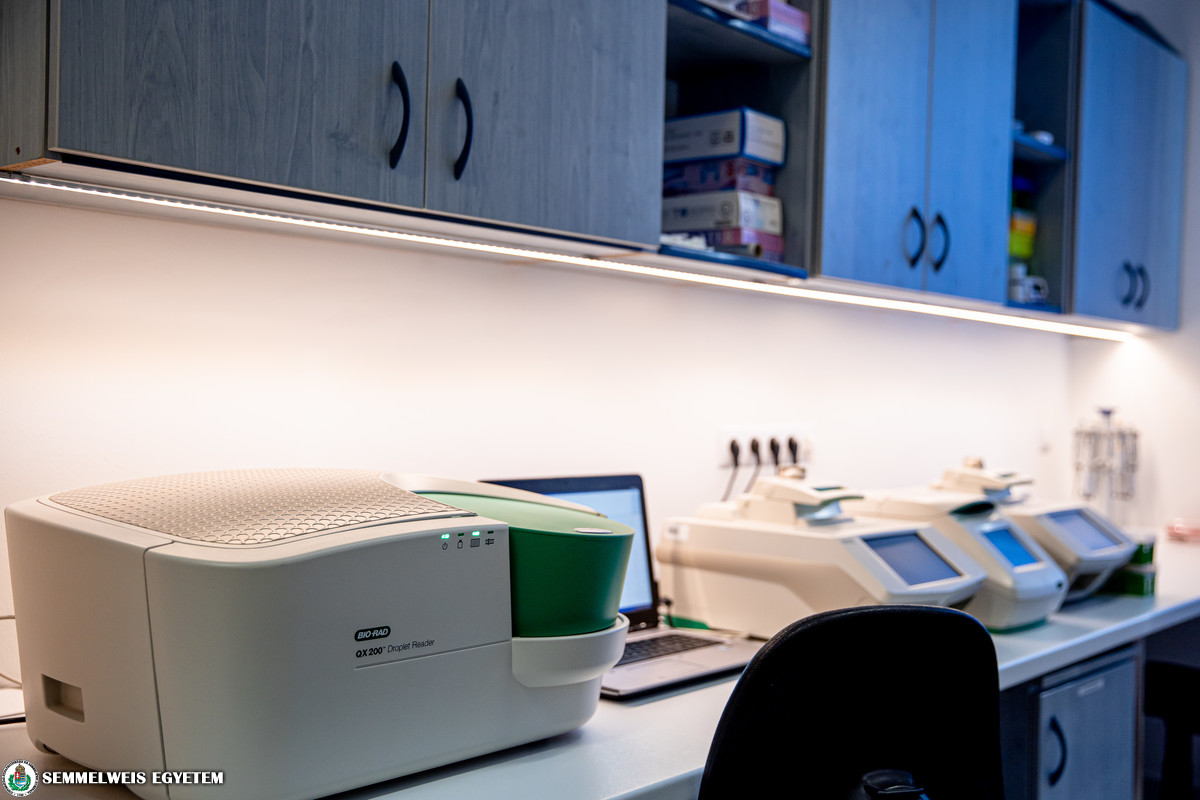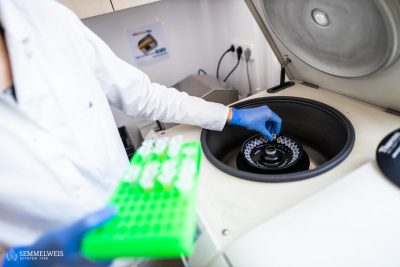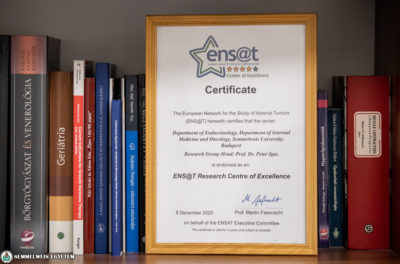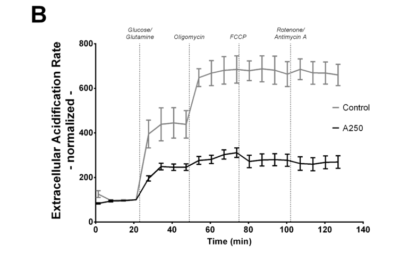A new generation sequencing device, which is unique in the Central European region, was installed at the molecular diagnostics laboratory of the 1st Department of Pathology and Experimental Cancer Research. Thanks to the state-of-the-art technology built in the device, it is capable of scanning twice as many samples at the same time as the previously used device. This allows the laboratory to support targeted tumour therapies and related research with greater efficiency and capacity than before. The acquisition of the device was realised within the oncogenomics grant application led by Dr. András Matolcsy and other development resources which fit in with institution’s development project started three years ago. A number of research and industry collaborations have been realised, such as an oncogenomic database of genetic differences of the most common tumour types and newly developed gene panels.
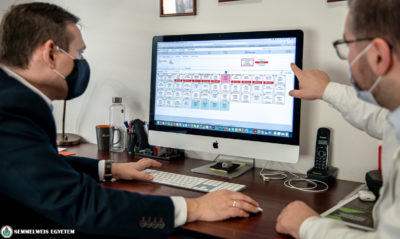 The development of the molecular diagnostics laboratory started three years ago within the framework of the Hungarian Oncogenome and Personalised Diagnostics and Therapy Programme led by the 1st Department of Pathology and Cancer Research. The new generation sequencing (NGS) technology was installed in the existing infrastructure at the end of last year. Based on the report of Dr. Csaba Bödör, research fellow at the 1st Department of Pathology and Experimental Cancer Research and head of the molecular diagnostics unit, the laboratory’s infrastructure includes the device, which is the most up-to-date technology currently available in the region, other NGS devices, digital PCR and Nanostring technology.
The development of the molecular diagnostics laboratory started three years ago within the framework of the Hungarian Oncogenome and Personalised Diagnostics and Therapy Programme led by the 1st Department of Pathology and Cancer Research. The new generation sequencing (NGS) technology was installed in the existing infrastructure at the end of last year. Based on the report of Dr. Csaba Bödör, research fellow at the 1st Department of Pathology and Experimental Cancer Research and head of the molecular diagnostics unit, the laboratory’s infrastructure includes the device, which is the most up-to-date technology currently available in the region, other NGS devices, digital PCR and Nanostring technology.
“An internationally competitive molecular diagnostic infrastructure has been set up at the university with its main profile being the comprehensive genetic analysis supporting targeted cancer therapies and focused genetic testing of various tumour types. The new device will also enable cost-effective exome sequencing studies at the university. During genomic profiling over 500 genes of a patient can be studied simultaneously in the lab, which is currently the most extensive and advanced oncological profiling available.”, Dr. Csaba Bödör said.
The process requires extremely close collaboration between the oncologist and the laboratory. The test may be initiated by the oncologist specialist if there is a chance of using personalized and targeted therapy in a patient. At the same time, it is important to understand that there are cases where no abnormalities can be found that could be treated by targeted therapy.
The bioinformatics background required for detailed analysis and the latest decision support system are available at the department, and a separate bioinformatics team led by Dr. Endre Sebestyén develop their own analytical algorithms.
“The oncologist, the pathologist, the molecular geneticist and the bioinformatician work in one team during the process, because this is how they can be most effective in performing and evaluating tests as well as in making therapeutic decisions.”, Dr. Csaba Bödör said.
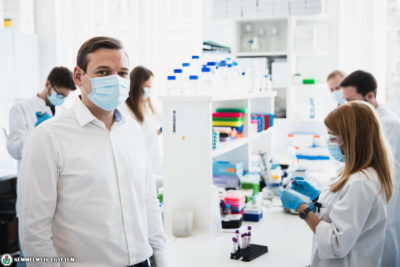 DNA and RNA are extracted from the tissue samples received by the department and they are entered into the sequencer where hundreds of genes are sequenced. The results of the sequencing show where genetic differences can be found, then the possible therapeutic targets for the identified differences are studied by software. At the end of the procedure the clinician is given a full report.
DNA and RNA are extracted from the tissue samples received by the department and they are entered into the sequencer where hundreds of genes are sequenced. The results of the sequencing show where genetic differences can be found, then the possible therapeutic targets for the identified differences are studied by software. At the end of the procedure the clinician is given a full report.
The procedure can be used study all types of tumours, including breast cancer and other gynaecological tumours, gastrointestinal tumours, tumours of the central nervous system and a wide range of paediatric oncological diseases. In the past year, nearly 100 patients have been screened with full profiling using the laboratory’s previous device. In addition, the lab tested the samples of nearly 2,000 patients with focused NGS tests last year. Thanks to the new sequencing device, the capacity of the lab will further increase, as it can run 20 tests simultaneously, which is twice the number of the samples they were able to test before.
“With the help of the laboratory infrastructure established within the framework of the development project we were able to launch the Hungarian Paediatric Leukemia Molecular Profiling Programme in collaboration with the Hungarian Paediatric Oncology Network. This allows the detailed genetic analysis of every Hungarian child with leukemia, which helps therapeutic decision making and risk assessment.”, said Dr. Csaba Bödör.
Within the framework of the programme, the Molecular Oncohaematology research group of the 1st Department of Pathology and Experimental Cancer Research led by Dr. Donát Alpár, senior research fellow developed gene panels that are used in everyday diagnostic practice. These gene panels also enable the study of fluid biopsy samples.
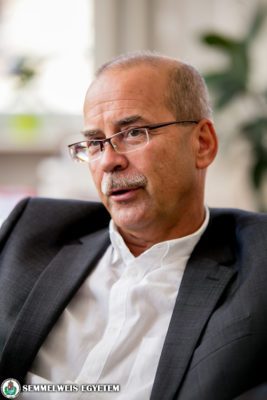 In addition to the infrastructure development, within the framework of the Hungarian Oncogenome and Personalised Diagnostics and Therapy Programme, they have also achieved significant scientific results related mainly to the development of different types of tumours, their clinical properties and characteristic molecular differences.
In addition to the infrastructure development, within the framework of the Hungarian Oncogenome and Personalised Diagnostics and Therapy Programme, they have also achieved significant scientific results related mainly to the development of different types of tumours, their clinical properties and characteristic molecular differences.
“The impact factor of the publications published by the consortium exceeds 300.”, said Dr. András Matolcsy, Director of the 1st Department of Pathology and Experimental Cancer Research and head of the Hungarian Oncogenome consortium.
The oncogenome database developed within the framework of the project will soon be available, which is important mainly in research and which contains the genetic differences of the most common tumour types also identified within the framework of the programme. This was developed by the university together with the research group of the Department of Complex Systems Physics at Eötvös Loránd University and the company 3D Histech Kft. Several other research projects use the infrastructure of the new molecular diagnostics lab, such as microbiome sequencing together with the Department of Medical Microbiology, and cardiogenetic testing in collaboration with the Városmajor Heart and Vascular Centre and the Department of Rare Diseases. Thanks to the collaboration, the study of more than 170 genes opened up the possibility of genetic testing in case of hereditary heart diseases.
The consortium leader of the project concluded at the end of 2020 was the 1st Department of Pathology and Experimental Cancer Research, the participants from the university were the Molecular Gastroenterology research group of the Department of Internal Medicine and Haematology, the 2nd Department of Pathology, the oncology unit of the Department of Internal Medicine and Oncology and the Department of Urology.
The members of the consortium included the Department of Complex Systems Physics at Eötvös Loránd University which took part in the development of the above mentioned database, and device development was carried out by 3D Histech Kft.
Pálma Dobozi
Photo: Attila Kovács – Semmelweis University
Translation: Ágnes Raubinek

